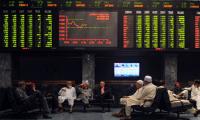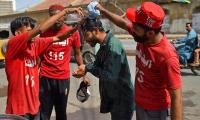The 17 United Nations Sustainable Development Goals (UN SDGs), announced at the UN Conference on Sustainable Development in Rio de Janeiro in 2012 are also supposed to be proposed public policy guidelines – at least for the member states of the UN that adopted the SDGs in 2015 to end poverty, protect the planet and ensure that all people enjoy peace and prosperity by 2030. The SDGs are also called ‘Global Goals’.
The SDGs’ aim has been to meet the global environmental, political and economic challenges the world is facing. The UNDP is said to be helping countries accelerate progress through its SDG integration function.
Pakistan is also trying to achieve these global goals. On February 16, 2016, parliament unanimously approved the SDGs as the National Development Agenda. A Parliamentary SDGs Secretariat was also formed at the National Assembly – one of the few countries to do so this at the government level. However, ‘this process of the legislation was the first and crucial step in mainstreaming and localizing the SDGs’.
The federal and provincial governments are to implement SDGs in the country. One often thinks of whether any concrete results have yet been achieved on the SDGs. Who are the stakeholders coming into the implementation of the SDGs? Is Pakistan accelerating progress or going in the reverse direction? Such questions have come up during SDG discussions or dialogues in the country.
It is believed that the SDGs are very crucial for Pakistan’s overall prosperity. Besides the development projects and programmes under the SDGs, the government must include SDGs at the local and tertiary level education system, because unless SDGs are made part of the syllabus in schools, colleges, and universities, graduating students will not know their importance in our daily life. It is a big task to include SDGs in the curriculum but once it is done the result will be good for Pakistan’s youth empowerment, entrepreneurs, and bottom-up development.
Pakistan has prioritized SDGs 1 (no poverty), 3 (good health and well-being), 4 (quality education), 6 (clean water and sanitation), 8 (decent work and economic growth) and 16 (peace, justice, and strong institutions). As of June 2016, 39 percent of Pakistanis lived in the tight grip of multidimensional poverty and more than 70 million of the population dwelled below the poverty line. The health sector too has never been a priority in the country.
Universities appear to be more visionary and objective-bound in attaining social development. Amid all Sindh’s universities, the Mehran University of Engineering & Technology (MUET), Jamshoro has established an Innovation and Entrepreneurship Centre (IEC) at its main campus. The IEC has implemented different projects and willingly applies the 17 SDGs in the criteria for successful applicants to get funding from the centre. Over 22 startup companies have graduated and are providing innovative solutions aligned with prioritized SDGs including Education (SDG 4), Energy (SDG 7), Food (SDG 2), Health (SDG 3), and Water (SDG 6).
The government needs to give the required attention to the SDGs. First, it can take innovators and social entrepreneurs on board, because they are more determined to solve the oldest issues and problems of society with new approaches and processes. Second, the government should look into the SDG implementation mechanism with new approaches.
Third, the UNDP, as an SDG implementing partner, must bring sustainable solutions for the proper functioning and outcomes of SDGs in the country. It may invest in the capacity building of SDG-related government officials in the federal and provincial setups and implementation stakeholders.
Fourth, for a layered outcome-based SDG implementation, the government should create room for universities where empirical research on SDGs could be conducted and their findings used to bring about innovative solutions. Immediately, for people’s prosperity and the planet’s safety, the government should rethink before it tries to utilize resources on the SDGs and their implementation through the current mechanism; rather, it should invest in finding innovative ways of implementing the SDGs.
It is to some extent good that we have good resources, planning and the will to implement but if we are weak at monitoring and evaluating the SDGs’ implementation then it would be hard to have our development expectations fulfilled and achieved. Monitoring the SDGs is another necessary component. In fact, it stands on the top before, during, and after SDG implementation. After all, only the prioritized and innovatively implemented SDGs would be able to bring sustainable development for all.
Technological progress is said to be very crucial for the country’s overall development and sustainability. And without technology and innovation, industrialization will not happen, and without industrialization, development will not take place.
The 22nd prime minister of Pakistan, Imran Khan has the mandate of the people of the country. He promised (during his pre-election campaigns) to bring Pakistan on the track of sustainability, prosperity and make the country an example of good governance. He has different windows of the opportunities including Pakistan Vision 2025 and the UN 17 SDGs.
Pakistan Vision 2025 talks about developments in education, health, and environment, etc, whereas SDGs are well-established guidelines for the countries of the world to bring sustainable development in many walks of life.
The nest eggs for infrastructure development (transport, irrigation, energy and, information and communication technology) are vital to attaining sustainable development. It has long been recognized that growth in productivity and incomes, and improvements in health and education outcomes require investment in infrastructure. According to the UN data, “470 million jobs are needed globally for new entrants to the labor market between 2016 and 2030.”
The prime minister must strive to alleviate poverty, which is the root cause of all problems, including suicide attempts by poverty-stricken women, domestic quarrels, social issues etc.
The government needs to analyze its actions and divert policy direction to development achievement. It should initiate and implement development programmes with the help of universities, business communities, research centres, media and industry, so the country can achieve prosperity and sustainability.
The writer is a freelance contributor. Email: furqanhyders@gmail.com
Twitter: @furqannppolicy
Approximately one in three women worldwide has experienced either physical and/or sexual intimate partner violence ...
Prime Minister Shehbaz Sharif has laid the foundation of a Daanish school in Islamabad’s Kuri Village
Ahfaz-ur-Rahman was also an Urdu poet of considerable reputation with his poems concerning a wide range of political...
In this picture taken on April 16, 2023, people throng a market area during shopping in Lahore. — AFPCare to cast...
A representational image of a transmission tower, also known as an electricity pylon. — AFP/FileLower electricity...
Pakistan's third Governor General Ghulam Muhammad. — National Portrait Gallery website/FileAs discussed in the...







